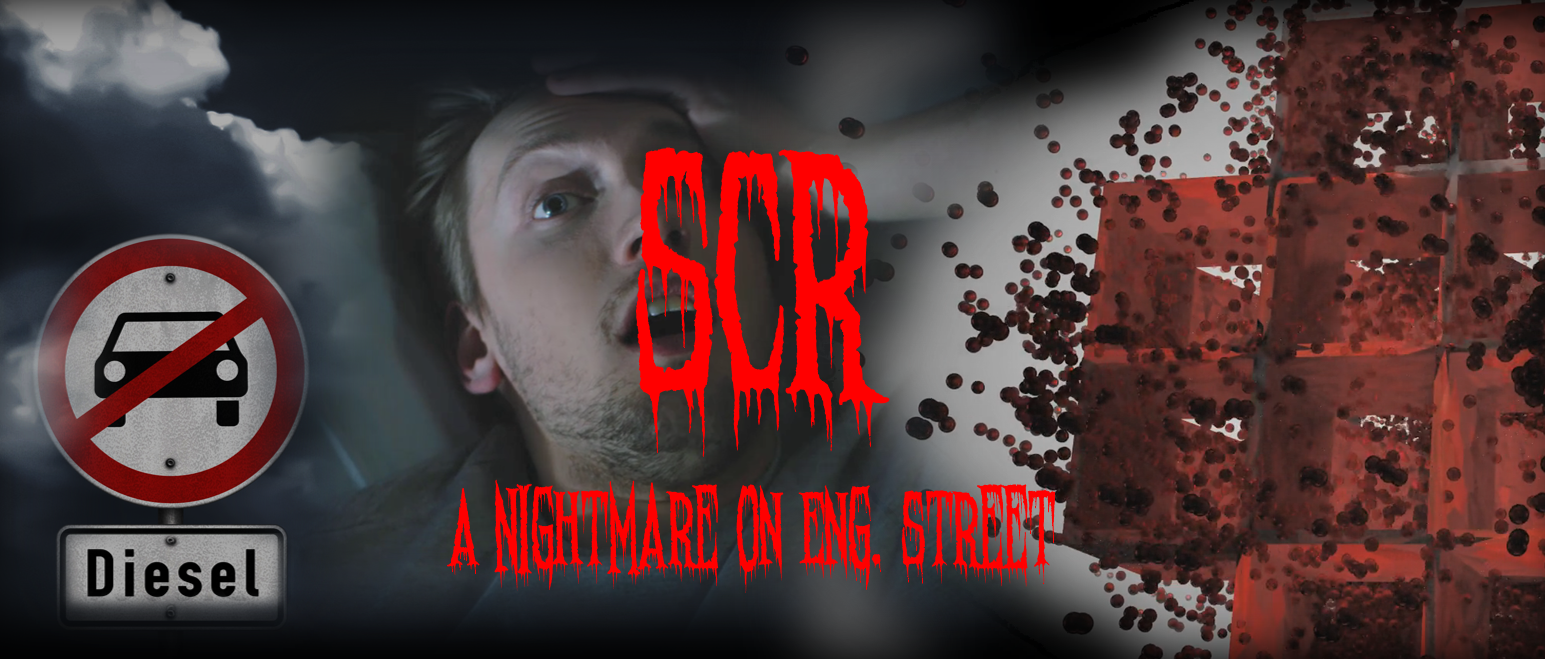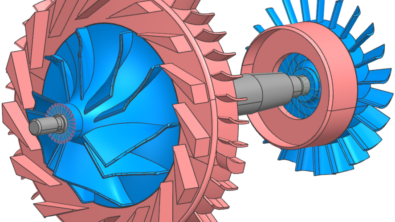SCR – a Nightmare on Eng. Street

Once upon a time there were four brothers. Their names were U, U, U and S. As the second two U’s were twins and just looked exactly the same everybody just called them double-U (“W”). When you had UWS stand in a line, they were looking like the Daltons from Lucky Luke but with three major differences: One, the middle two Us had the same size, two, they all had no head, no arms, no legs: They were just perfect spheres in perfect beauty of nature’s symmetry, three, they were as tiny as 20 microns, 30 microns, 30 microns and 40 microns, respectively.
That said, in average this made them the size of 30 microns, but despite this tiny fact their fate caused an impact of 30 billion dollars and still causes a nightmare to hundreds of engineers. You wonder how this is even possible. Well, this is the story of
SCR – a Nightmare on Engineer’s Street
It was a cold winter night when U, W and S found themselves in a dark narrow room with no windows and only two doors that were apparently locked. The four brothers were squeezed into that prison of no daylight with billions of other droplets that they had never seen before. It was freezing cold and some of the other drops were already stuck, frozen to one-another or to the cold metallic walls of the frightening chamber. “Never touch the metal, unless you know its temperature”, their mother had always told them. “If it’s too cold you will get stuck, if it’s too hot you will burn your tongue…at best…”
While things were not quite comfortable, U, W and S made the best of the situation in their new “home”. While it was cold, at least it was quiet and still and they would rest among the other unfrozen mates.

Until that moment, when out of a sudden the crowd got shaken up by a loud screaming noise, the tank beginning to shake and one of the doors opening and with an almighty force sucking a good bunch of the drops out of the crowd through the door into the unknown beyond.
Among the unlucky chunk was S, the tallest of the brothers.
S was taken on the craziest rides he ever experienced. Bearing the words of his mother in mind he tried to not touch a wall. In the bulk of liquid, he was taken through a long labyrinth of pipes, first at moderate speed, then, as the bulk reached something that looked like the light at end of the tunnel, faster and faster. Out of a sudden he was squeezed through a tiny orifice, so small that only a few of the droplets would make it through next one to another at a time. They accelerated further and exited the nozzle into another, yet way more dirty, smoky and stinky pipe. The cross flow of the dirty winds that blew hard against the plume of drops gave S another kick and blew him away from his original track. “Don’t touch the wall, don’t touch the wall,…” he repeated in hesitation at a high pitched voice.
Then – of course –
in case you have not realized yet: this is a horror story. This is not for the faint-of-heart- if you are among those, stop reading here
it hit him hard, like a hammer, he hit a wall and the last thing he recalls were his mother’s words about cold walls. But it was worse than what she had always told him, he did not just stick to the wall, he got busted into pieces, some of which would be torn down further downstream by the almighty force of the dirty stinky flow, some residuals of him sticking to the wall and merging with other drops that experienced the same abrupt end of their exciting ride. All that was left of proud perfectly shaped spherical S was a sad-looking puddle of liquid. And it got worse, more drops hit, burst by burst the rest of S was diluted into an ever-growing puddle until he got dissolved in the anonymous puddle of pity. Then – to make a sad story a complete tragedy – the puddle solidified and the old mates, destroyed, diffracted, torn apart got baked to an ugly looking cake – porous, diffracted, stinking, solid as a rock.

This was it…
…for S.
Think this is just a horrible brutal story!? Well, give me another burst:
Next, U: After they saw what happened, the remaining three brothers tried to hide in one of the corners of the tank as far away from the frightening exit as possible. But sloshing around, U got separated from W and mixed up and -finally- he was sucked through the door. Like his big brother, U experienced the same crazy ride through a labyrinth of pipes and through that narrow nozzle. But something had changed as he exited the nozzle into the stinky cross flow… something that made things even worse for U than for S: Now, the dirty, smoky stinky flow was not only dirty, smoky and stinky, it was hot like hell and it blew even harder than before.
U was taken downstream right after he exited the nozzle, he hit a wall, burned his body, some of which vaporized into nirvana, bounced back again, hit another wall, burned his body again, bounced off again, hit it again and again and again. He recalled his mother’s words about hot metallic walls when suddenly the bouncing found an abrupt end with one final smash on what was left of U. He hit a hard ceramic surface frontally which made him burst into pieces just like S.

That was it…
…for U.
Man, this is weird stuff! This is not a Simulation blog is it?
Well, let’s finish up here and I will come back to that
Next W:
Needless to say now, sloshing in the tank continued and -of course- W got sucked into the labyrinth of pipes. They made their way to the orifice just like their brothers. But something changed: For them it was a fun ride. They were together still, they were the crazy dudes, you know, and always thought life was a roller-coaster. Laughing out loud they jointly exited the nozzle into a hot, but for their taste well-tempered pipe of gaseous flow. Still, the surrounding was dirty and stinky, but the two brothers just did not care. They even loved the crazy ride. And then, like for U and S they hit that wall…
That instant moment they got diffracted into the tiniest droplets they had ever seen before, it was a busting worse than S had experienced it and a vaporization a thousand times crazier than for U: It was the ultimate implosion into a gaseous cloud of peace and harmony down to the last molecule of W. All that was left from W was a cloud of gas diluting into the warm surrounding flow that smoothly took them to their ultimate destination. And even better, all the other drops that were on the fun ride experienced the same ultimate fate.
When their molecules reached the end of the tunnel they found themselves in true homogeneity with all their mates and in even distribution with their environment. What a ride, what an end of life!
All right, happy end, then. Kind of at least. And the moral of this story?
When finally the cloud of the W’s molecules traveled through the porous brick, btw his name was SCR catalyst, they thanked him for the warm welcome. The catalyst said: “Don’t thank me. Thank the mixing element that you met further upstream! It was actually him who made you experience this!” As the mixing element heard that conversation it responded: “You don’t have to thank me either…” The residuals of W looked at the mixing element, puzzled and in obvious confusion. “Well then, whom shall we thank?” “Well let me explain it to you in brief words” said the mixer,
“If you develop an SCR Diesel aftertreatment system, like the one above, it’s all about thermal management. One key is to understand the Nukiyama boiling curve: It is about the fundamentals of heat transfer between you, Urea Water Solution droplets and a wall like myself.

Look at the graph above: if my temperature had been too low, the heat I would have given to you upon your impact would be low, you would have stuck on me for ages, cumulated there, formed a puddle and – if things go totally wrong – even formed an ugly solid deposit, just like your brother S.
On the contrary, if I had been too hot, greetings from U’s fate. Despite the hot gas, you would never have vaporized fast enough because it is the solid-liquid heat transfer that dominates over the gaseous-liquid heat transfer by two orders of magnitude and therefore determines your lifetime. You would have travelled all the way to the catalyst bouncing around on your own tiny vapor cushion. This is well known as the Leidenfrost-effect. Put a drop of water on a heated plate and watch it dancing for ages and you know what I mean. Finally, you would have hit the catalyst as a liquid and there would have been no time / pipe length left for gaseous mixing. You would have caused an ammonia hotspot at the catalyst or even worse maybe another cruel deposit at its entrance.
But then – life’s not linear you know, just like this curve – there is a sweet spot in that boiling curve: Some call it the Nukiyama boiling point, some the critical heat flux temperature. Whatever you call it, that’s the place to be for us, that’s where you guys better hit me. It will maximize the heat I can give to you when we meet. It will make your life’s end the shortest possible. It will make you a proper homogeneous ammonia cloud when you enter the catalyst. Sounds cruel at first sight, I know, but as you have seen, of all possible it is the best fate you can experience. This ensures you guys will reach the catalyst in best possible conditions – no solid piece of crap, no bouncing-around for ages, you will come as relaxed ammonia molecules – well stirred and ready to make the stinky dirty smoky exhaust flow pure clean air as it exits the catalyst!
But that’s only the tip of the iceberg: in the end your fate is determined by a nearly endless number of factors: your size, your speed, the gas and wall temperatue, the gaseous mass flow, your dynamic and thermodynamic interaction with the wall, your turbulent interaction with the flow, the dynamics as you form a liquid film, the gaseos state above it, how fast you evaporate, potential undesired secondary reactions triggered by your complex chemistry, the turbulent mixing once you vaporized, finally all this related to how one times and targets your pulsed injection in a highly transient environment, … if you gotta cope with this it’s a nightmare, you know…
Guys? Guys,… are you still listening?”
“Ehmm, yes, sure. We were just thinking.”
The molecules stared at the mixing element for a moment and then uni sono said:
“This is weird indeed, thank you so much for those insights, mixer!”
Humbly, the mixer responded:
“Don’t thank me. It’s not my success. You should thank the engineers out there that spend a lifetime on the fundamentals of sprays, wall-heat transfer, impingement, turbulent mixing, evaporation, boiling, chemical reactions and god knows what. Those that acknowledge the importance of fundamental physics to exhaust gas aftertreatment. Thank those engineers that take the fundamentals of these complex physics and chemistry seriously. It is them who try to make your ride the most life-saving of all possible.
Thank those engineers that go through the nightmare on engineer’s street and find your sweet dream solution to make Diesel exhaust gas cleaner.”
“This is amazing” the ammonia cloud said in deep respect. “How do they do this?”
“I would rather bet they are using Simcenter.”
said the mixer.
Start to end your engineering nightmare today:
Optimizing exhaust systems for emissions reduction using simulation (On-Demand Webinar)
Recent advances & enhancements for aftertreatment systems simulation (On-Demand Webinar)
Bridging the Time Scale gap in SCR CFD
[1] Smith, Henrik & Lauer, Thomas & Mayer, Mattias & Pierson, Steven. (2014). Optical and Numerical Investigations on the Mechanisms of Deposit Formation in SCR Systems. SAE International Journal of Fuels and Lubricants. 7. 525-542. 10.4271/2014-01-1563.
[2] Xu, L., Watkins, W., Snow, R., Graham, G. et al., “Laboratory and Engine Study of Urea-Related Deposits in Diesel Urea-SCR After-Treatment Systems,” SAE Technical Paper 2007-01-1582, 2007, https://doi.org/10.4271/2007-01-1582.
[3] Vlachou, Maria & Lioumbas, John & Karapantsios, Thodoris. (2016). Heat transfer enhancement in boiling over modified surfaces: A critical review. Interfacial Phenomena and Heat Transfer. 3. 10.1615/InterfacPhenomHeatTransfer.2016014133.


